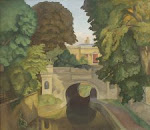All of this activity takes place within the low-angled golden sunlight of late February and early March, the counterpart of the slanting sunlight of late August and early September. The light of Paradise. A World aglow, in which all colors take on deeper and richer hues. This is particularly true of the meadows and the lawns, which are heartbreakingly and wistfully green.
For now, I am here,
but can one trust the future?
No, not in a world
that teaches us its ways
with the morning glory.
Izumi Shikibu (c. 970 - c. 1030) (translated by Steven Carter), in Steven Carter, Traditional Japanese Poetry: An Anthology (Stanford University Press 1991), page 120.
Ian MacInnes (1922-2003), "Harvest, Innertoon" (1959)
The joy of arrival and the sadness of departure. At all times, and in every season, this is what the World teaches us. It is the story of our life, isn't it?
Each spring, I am delighted to come upon the first crocuses. Implicit in this delight (but unstated) is the knowledge that this arrival betokens an eventual departure. But seeing the crocuses is never an occasion for sinking into a melancholy meditation on mortality. Quite the opposite.
And so it goes with each of the beautiful particulars of the World.
Betty Corrigall lived on the island of Hoy in Orkney in the 18th century. When she was in her late twenties, she was abandoned by her lover after becoming pregnant. She committed suicide. Given the circumstances of her death, a kirkyard burial was not permitted. She was buried in an unmarked grave out on the moor. In the early 1930s, her coffin was discovered by peat diggers. In 1949, a visiting American minister performed a burial service for her. A white marker was placed on her grave in 1976. It reads: "Here Lies Betty Corrigall."
George Mackay Brown wrote a short story about her, an imaginative rendering of the final months of her life. The story begins with an introductory paragraph:
"In the moorland of the island of Hoy in Orkney, right on the boundary that separates the two parishes of Voes (Walls) and North Hoy, a gravestone and fence have recently been erected by some islanders. Underneath lay, peat-preserved for well over a century, the body of a young woman who had obviously committed suicide. Only her name survives: Betty Corrigall."
George Mackay Brown, "Betty Corrigall", in Northern Lights: A Poet's Sources (edited by Archie Bevan and Brian Murray) (John Murray 1999), page 225.
Brown also wrote a poem about her.
Betty Corrigall
The girl buried in the moor
Child
in the blue scarf of wind
begin to dance
Girl
in the yellow coat of sun
ripeness is here
Woman
in the gray sheet of water
steep your griefs
Queen
lie robed from looms of earth
Persephone
George Mackay Brown, Ibid, page 231.
It is said that Betty Corrigall's body, having been interred in peat, was well-preserved when it was discovered. "And while that generation of islanders withered slowly into death, one after another, and after death rotted more urgently until they achieved the cleanness of skeletons, the deep peat moss kept the body of Betty Corrigall uncorrupted; though stained and darkened with the essences that had preserved it." George Mackay Brown, "Betty Corrigall," Ibid, page 230. Persephone in Orkney: queen of the underworld and goddess of spring.
Stanley Cursiter (1887-1976), "Orkney Landscape" (1952)
Yesterday afternoon I stood at the entrance to an avenue of trees. The two rows of trees are bare, but beautiful, at this time of year: an endlessly complex network of branches, not a twig out of place, set against the sky. For a moment, I brought to mind how the avenue looks in each of the seasons, and I imagined that I could see an entire year of branches and leaves pass in sequence before my eyes.
We are time-bound, but it is possible to experience timelessness and eternity. "They will endure beyond our vanishing;/And they will never know that we have gone." (Jorge Luis Borges (translated by Stephen Kessler), "Things.") I find comfort in that thought.
The Ring of Brodgar is a stone circle located on the Mainland of Orkney. George Mackay Brown wrote a sequence titled "Brodgar Poems," which consists of 28 short poems, each bearing the number of one of the standing stones in the circle. The sequence begins with a prose introduction:
"The poem sees the work on this Neolithic stone circle as lasting two or three generations at least. 'She who threw marigolds over you . . . is a crone now with cindery breath . . .'
"It may have been a meeting-place, a temple, a hymn to the sun and the stars.
"Even as a civilisation is being established, its history is beginning to crumble. Strange boats from time to time sailed along the horizon, going north and west, threatening the precarious settlements.
"But a circle has no beginning or end. The symbol holds. People in AD 2000 are essentially the same as the stone-breakers and horizon-breakers of 3000 BC."
George Mackay Brown, from "Brodgar Poems" (1992), in Archie Bevan and Brian Murray (editors), The Collected Poems of George Mackay Brown (John Murray 2005).
"A circle has no beginning or end." We can be acutely -- and heartbreakingly -- aware of the arrival and departure of the World's beautiful particulars, yet still feel a sense of constancy and continuity. Is it possible that nothing ever truly vanishes?
The Eleventh Stone
They say, never such loveliness between the lochs
As that girl.
In the pause between two stones
She became a swan.
She flew from us into sunset and stars.
George Mackay Brown, Ibid.
"The Eleventh Stone" brings this to mind:
The beauty of Xi Shi's countenance -- where is it now?
In the tips of the wild grasses, swaying in spring wind.
Yüan Chen (779-831) (translated by Steven Carter), in Steven Carter, Traditional Japanese Poetry: An Anthology (Stanford University Press 1991), page 127.
Ian MacInnes, "Yesnaby" (1979)
Are these ruminations about arrivals and departures, timelessness and eternity, nothing but wishful thinking? Whistling past the graveyard? Perhaps. Yet why eliminate any possibilities?
I harbor no illusions: we live in a crocus and morning glory world. Silence awaits. But is silence the end?
Gravestone
Suddenly a stone chirped
Bella's goodness,
Faithfulness,
Fruitfulness,
The numbers
Of Bella's beginning and end.
It sang like a harp, the stone!
James-William of Ness
Put a shilling
In the dusty palm of the carver,
Fifty years since.
Wind, snow, sun grainings.
The stone's a whisper now.
Soon
The stone will be silence.
George Mackay Brown, from "Seal Island Anthology, 1875," in Voyages (Chatto & Windus 1983).
Stanley Cursiter, "A Farm in Orkney" (1952)









